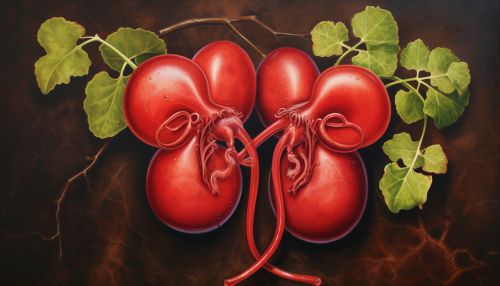Kidney
Anatomy of the Kidney
The kidneys are two bean-shaped organs located in the posterior part of the abdomen. Each kidney is about the size of a fist and weighs approximately 150 grams. They are located on either side of the spine, at the level of the middle back, just below the rib cage. The right kidney is usually slightly lower than the left due to the presence of the liver.


The kidneys are surrounded by a layer of fat, which helps to protect them from injury. Each kidney is encased in a tough fibrous capsule, which also provides some protection. The outer layer of the kidney is called the cortex, and the inner layer is known as the medulla.
The cortex contains the majority of the kidney's nephrons, which are the functional units of the kidney. Each kidney contains approximately one million nephrons. The nephrons filter the blood and produce urine, which is then transported to the bladder via the ureters.
The medulla contains the collecting ducts, which are responsible for the final concentration of urine. The medulla is divided into several pyramid-shaped regions, known as renal pyramids. The tips of the renal pyramids, called renal papillae, point towards the center of the kidney, where the renal pelvis is located.
The renal pelvis is a funnel-shaped structure that collects urine from the renal pyramids and transports it to the ureter. The ureter is a tube that carries urine from the kidney to the bladder.
Function of the Kidney
The primary function of the kidneys is to filter waste products and excess substances from the blood, and to regulate the body's balance of electrolytes, acid-base balance, and blood pressure. The kidneys also produce several important hormones, including erythropoietin, which stimulates the production of red blood cells, and renin, which regulates blood pressure.
The kidneys filter approximately 180 liters of blood per day, producing about 1.5 liters of urine. The process of filtration occurs in the nephrons. Each nephron consists of a glomerulus, which is a network of tiny blood vessels, and a tubule, which is a small tube where urine is formed.
The glomerulus filters the blood, removing waste products and excess substances. The filtered fluid, known as filtrate, then passes into the tubule. In the tubule, some substances, such as glucose and certain ions, are reabsorbed back into the blood, while others, such as urea and creatinine, are excreted in the urine.
The kidneys also play a crucial role in maintaining the body's acid-base balance. They do this by excreting hydrogen ions and reabsorbing bicarbonate ions, which helps to keep the pH of the blood within a narrow range.
Diseases of the Kidney
There are many diseases that can affect the kidneys, including kidney stones, infections, cancer, and chronic kidney disease (CKD).
Kidney stones are hard deposits of minerals and salts that form in the kidneys. They can cause severe pain when they pass through the urinary tract. Kidney infections, also known as pyelonephritis, are usually caused by bacteria that enter the kidneys from the bladder.
Kidney cancer is a type of cancer that starts in the kidneys. The most common type of kidney cancer in adults is renal cell carcinoma, while the most common type in children is Wilms' tumor.
Chronic kidney disease is a long-term condition where the kidneys do not work as well as they should. It is often caused by conditions such as diabetes and high blood pressure, which damage the kidneys over time.
Treatment of Kidney Diseases
The treatment of kidney diseases depends on the specific disease and its severity. Kidney stones, for example, are often treated with pain medication and increased fluid intake. In some cases, medication may be prescribed to help dissolve the stones, or a procedure may be needed to remove or break up the stones.
Kidney infections are typically treated with antibiotics. In severe cases, hospitalization may be required.
Kidney cancer is usually treated with surgery to remove the cancerous kidney. Other treatments, such as radiation therapy or chemotherapy, may also be used.
Chronic kidney disease is often managed with lifestyle changes, such as a healthy diet and regular exercise, and medication to control associated conditions like high blood pressure and diabetes. In advanced stages of CKD, dialysis or a kidney transplant may be necessary.
